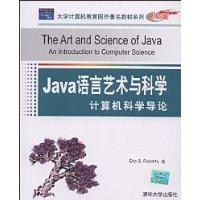內容簡介
《Java語言藝術與科學:計算機科學導論》採用了Java庫函式的方法,強調抽象的原則,詳細闡述了庫和模組化開發。此外,《Java語言藝術與科學:計算機科學導論》還利用大量實例講述解決問題的全過程,對開發過程中常見的錯誤也給出了解決和避免的方法。
作者簡介
Eric S. Roberts,美國史丹福大學計算機科學系教授,並擔任主管教學事務的系主任。他由於教學改革所取得的成就被評為Charles Simonyi榮譽教授。他於1980年獲得哈佛大學套用數學博士學位,並曾在加州Palo Alto的DEC公司的系統研究中心工作了5年。作為一位成功的教育工作者,Roberts還獲得了1993年的Bing Award獎。
編輯推薦
《Java語言藝術與科學:計算機科學導論》是關於數據結構、程式設計和軟體工程的絕佳入門書籍,既可作為高等院校計算機科學導論課程及Java語言程式設計課程的教材,也是Java語言開發人員的極佳參考用書。
英文目錄
1 In.roducfion
1.1 A brief history ot computinq
1.2 What is computer science?
1.3 A brief tour of computer hardware
1.4 Alaorithms
1.5 Staaes in the Droaramminq orocess
1.6 Java and the obiect-oriented paradigm
1.7 Java and the World Wide Web
Summary
Review questions
2 Programming by Example
2.1 The "Hello world" program
2.2 Perspectives on the programming process
2.3 A program to add two numbers
2.4 Programming idioms and patterns
2.5 Classes and objects
2.6 Graphical programs
Summary
Review questions
Programming exercises
3 Expressions
3.1 Primitive data types
3.2 Constants and variables
3.3 Operators and operands
3.4 Assi.qnment statements
3.5 Boolean expressions
3.6 Designing for change
Summary
Review questions
Programming exercises
4 Statement Forms
4.1 Statement types in Java
4.2 Control statements and problem solving
4.3 The if statement
4.4 The switch statement
4.5 The while statement
4.6 The for statement
Summary
Review questions
Programming exercises
5 Methods
6 Objects and Classes
7 Objects and Memory
8 Strings and Characters
9 Object-oriented Graphics
10 Event-driven Programs
11 Arrays and ArrayLists
12 Searching and Sorting
13 Collection Classes
14 Looking Ahead
Index
中文目錄
第1章 前言
1.1 計算簡史
1.2 計算機科學的含義
1.3 計算機硬體簡介
1.4 算法
1.5 編程過程的幾個階段
1.6 Java和面向對象範例
1.7 Java和WWW
1.8 小結
1.9 複習題
第2章 編程示例
2.1 “Hello world”程式
2.2 編程過程的觀點
2.3 兩數相加的程式
2.4 編程習語和模式
2.5 類和對象
2.6 圖形程式
2.7 小結
2.8 複習題
2.9 編程練習
.第3章 表達式
3.1 原始數據類型
3.2 常量與變數
3.3 運算符和運算元
3.4 賦值語句
3.5 布爾表達式
3.6 設計改變
3.7 小結
3.8 複習題
3.9 編程練習
第4章 語句形式
4.1 Java的語句類型
4.2 控制語句和問題解決
4.3 if 語句
4.4 switch語句
4.5 while語句
4.6 for語句
4.7 小結
4.8 複習題
4.9 編程練習
第5章 方法
5.1 方法概述
5.2 編寫自己的方法
5.3 方法調用過程的技巧
5.4 分解
5.5 算法方法
5.6 小結
5.7 複習題
5.8 編程練習
第6章 對象和類
6.1 使用RandomGenerator類
6.2 javadoc文檔系統
6.3 定義自己的類
6.4 表示學生信息
6.5 有理數
6.6 擴展現有類
6.7 小結
6.8 複習題
6.9 編程練習
第7章 對象和記憶體
7.1 記憶體結構
7.2 將記憶體分配給變數
7.3 原始類型與對象
7.4 連結對象
7.5 小結
7.6 複習題
7.7 編程練習
第8章 字元串和字元
8.1 枚舉的原則
8.2 字元
8.3 作為抽象概念的字元串
8.4 使用string類中的方法
8.5 字元串處理案例研究
8.6 小結
8.7 複習題
8.8 編程練習
第9章 面向對象圖形
9.1 acm.graphics模型
9.2 acm.graphics程式包的結構
9.3 使用形狀類
9.4 創建複合對象
9.5 小結
9.6 複習題
9.7 編程練習
第10章 事件驅動程式
10.1 Java事件模型
10.2 簡單的事件驅動程式
10.3 回響滑鼠事件
10.4 回響鍵盤事件
10.5 創建簡單的GUI
10.6 Swing 互動器層次結構
10.7 管理組件布局
10.8 使用TableLayout類
10.9 小結
10.10 複習題
10.11 編程練習
第11章 數組與ArrayList類
11.1 數組簡介
11.2 數組的內部表示法
11.3 數組作為參數傳遞
11.4 使用數組製作表格
11.5 數組初始化
11.6 多維數組
11.7 圖像處理
11.8 ArrayList類
11.9 小結
11.10 複習題
11.11 編程練習
第12章 搜尋與排序
12.1 搜尋
12.2 排序
12.3 評估算法效率
12.4 使用數據檔案
12.5 小結
12.6 複習題
12.7 編程練習
第13章 數組與ArrayList類
13.1 ArrayList類回顧
13.2 HashMap類
13.3 Java集合架構
13.4 面向對象設計的原則
13.5 小結
13.6 複習題
13.7 編程練習
第14章 展望
14.1 遞歸
14.2 並發
14.3 使用網路
14.4 編程模式
14.5 小結
14.6 複習題
14.7 編程練習

